Hospice Nurse Resume Examples
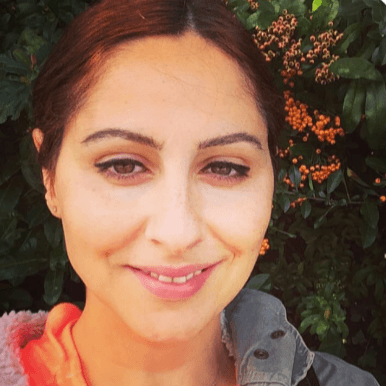
Jul 18, 2024
|
12 min read
Ease hearts and land jobs: tips for writing a hospice nurse resume that heals professionally. Craft a heartfelt resume that stands out, showcases your skills, and secures your next compassionate caregiving role.
Rated by 348 people

Pediatric Hospice Nurse
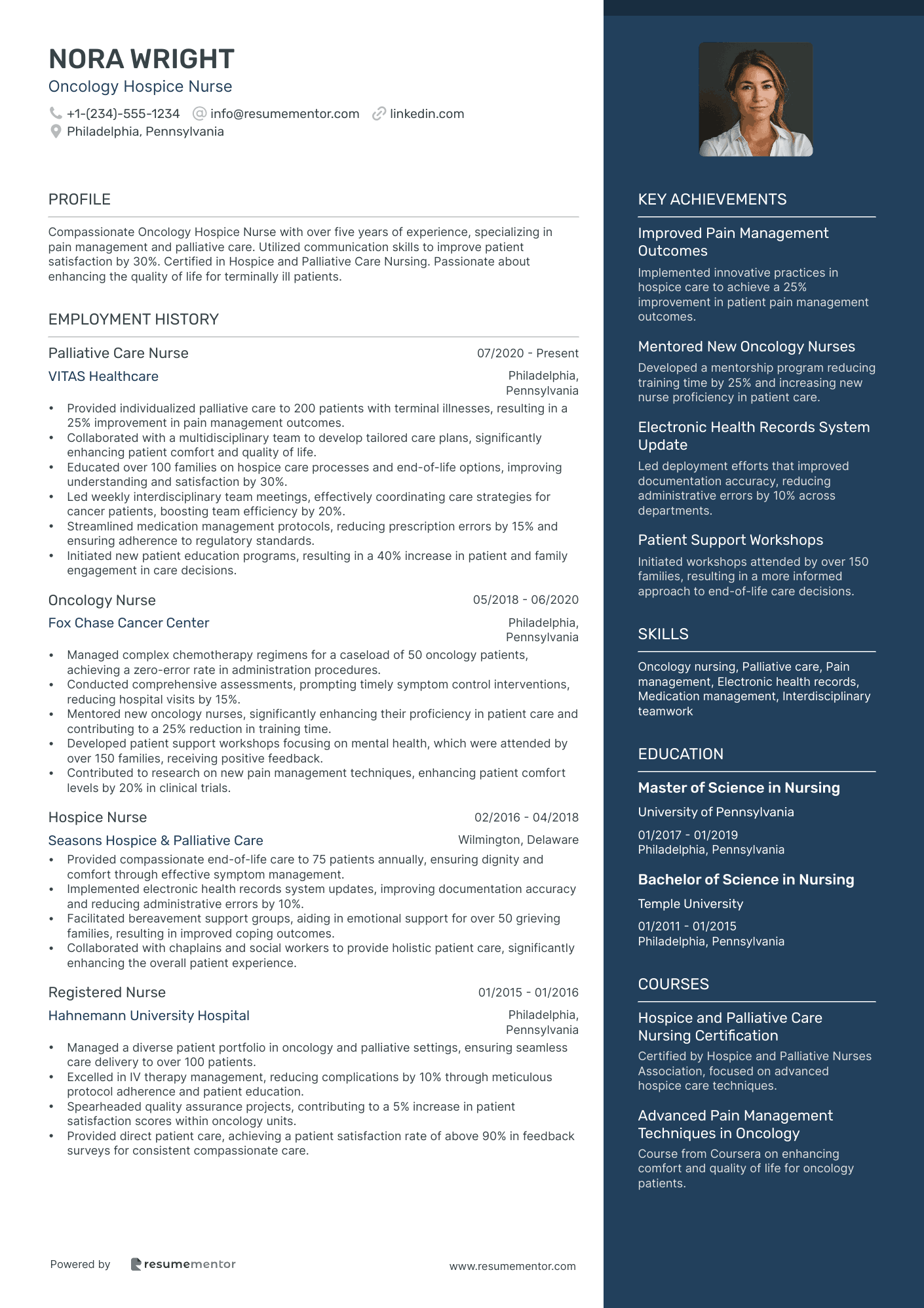
Oncology Hospice Nurse
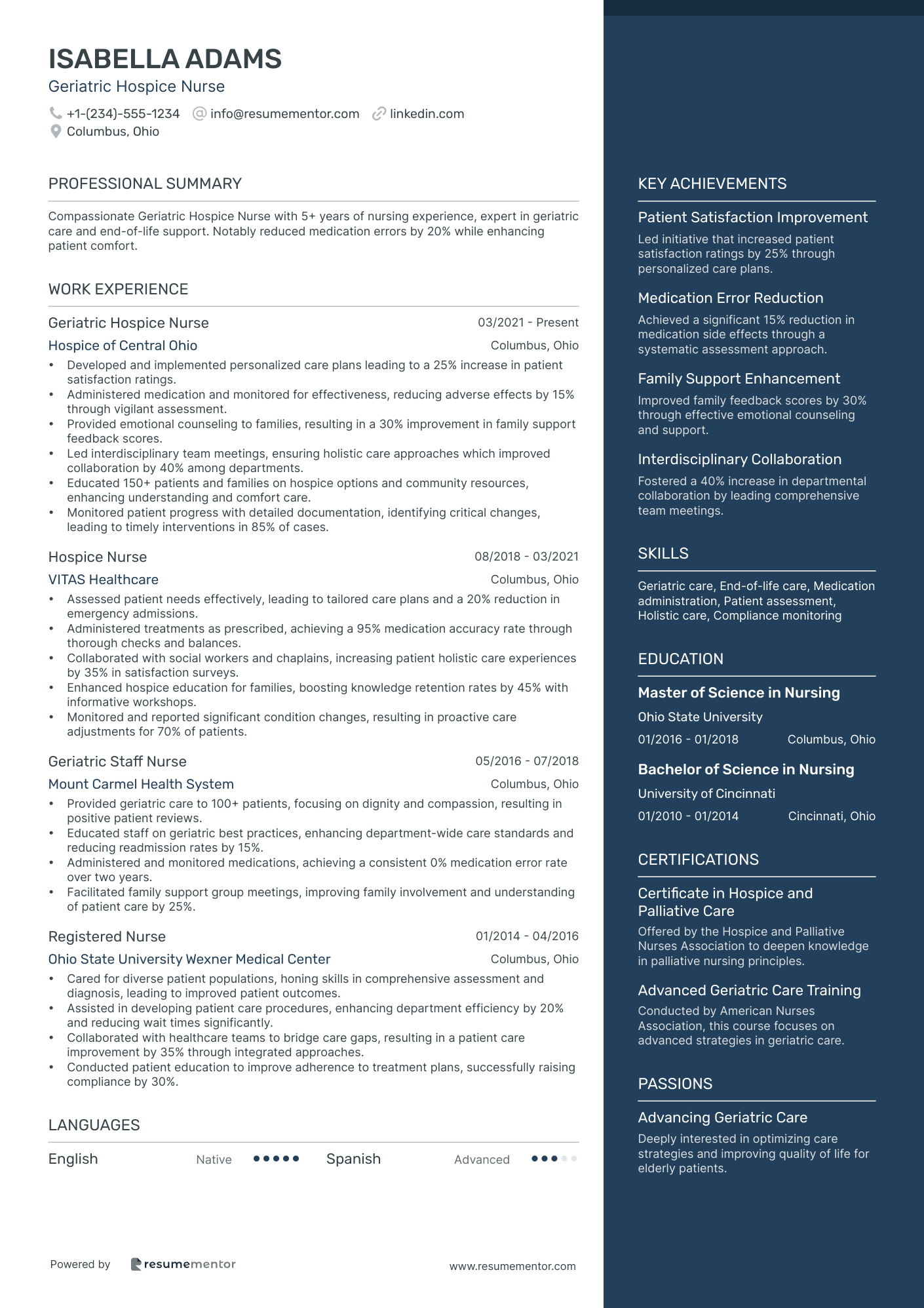
Geriatric Hospice Nurse
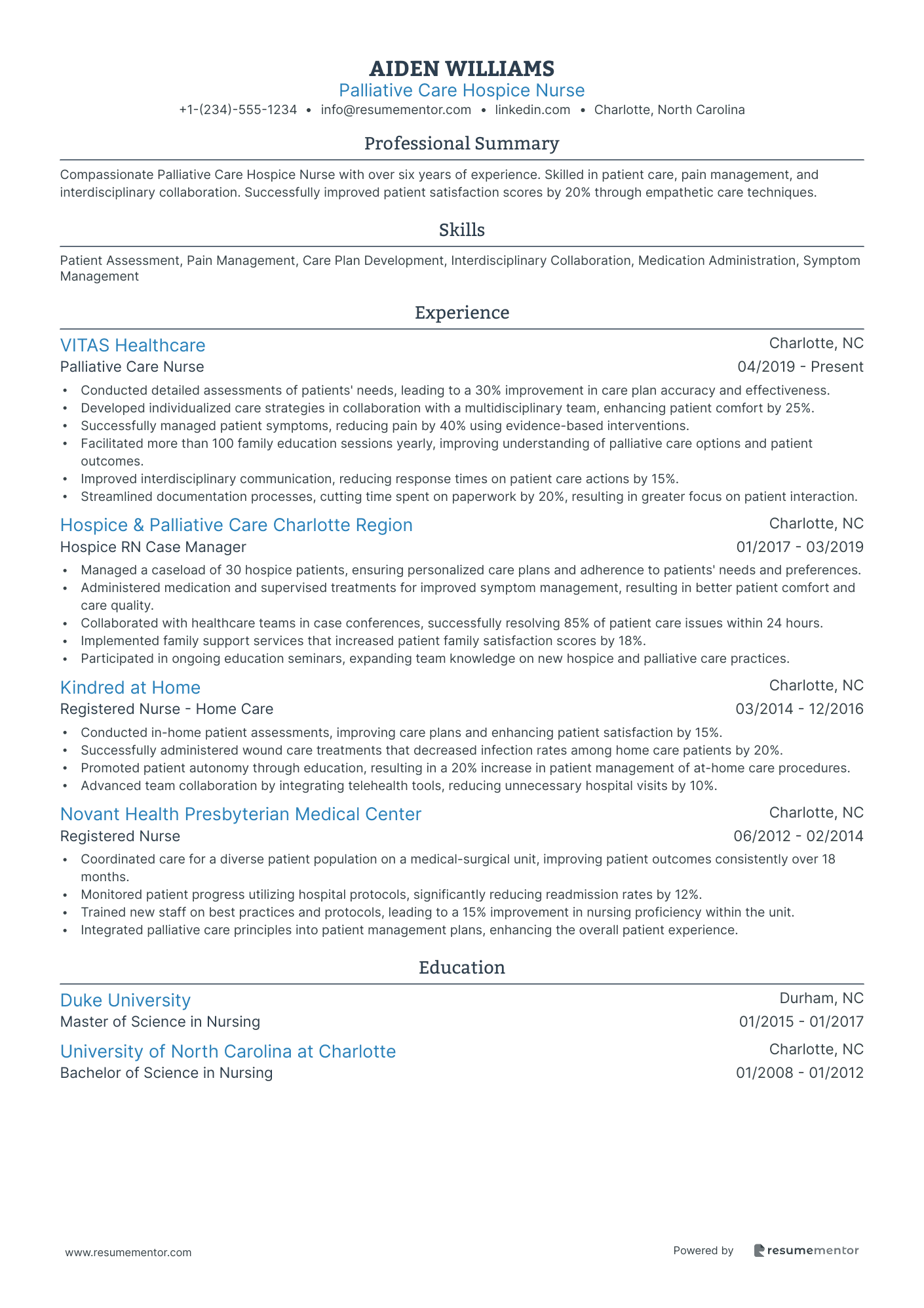
Palliative Care Hospice Nurse
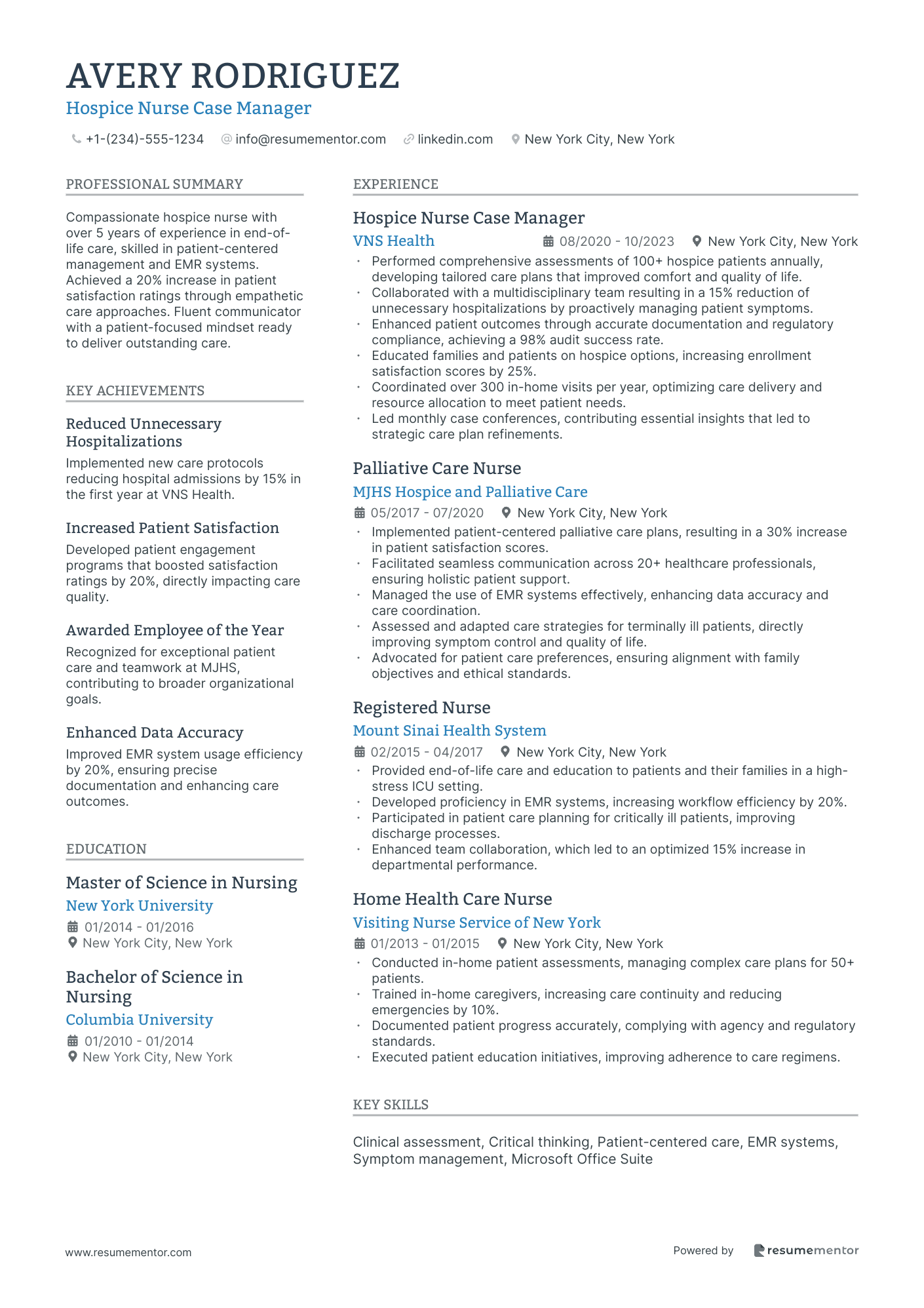
Hospice Nurse Case Manager
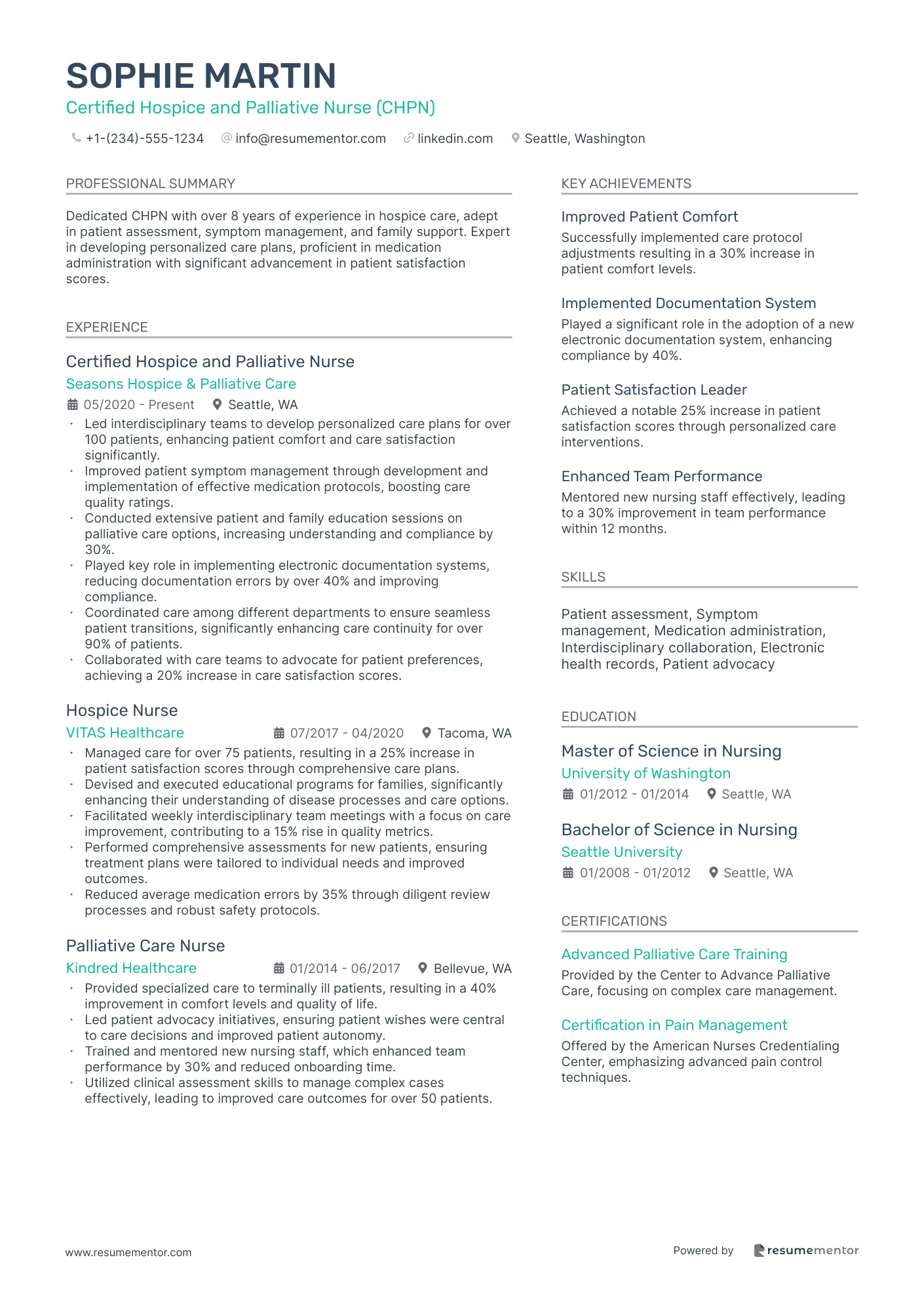
Certified Hospice and Palliative Nurse (CHPN)
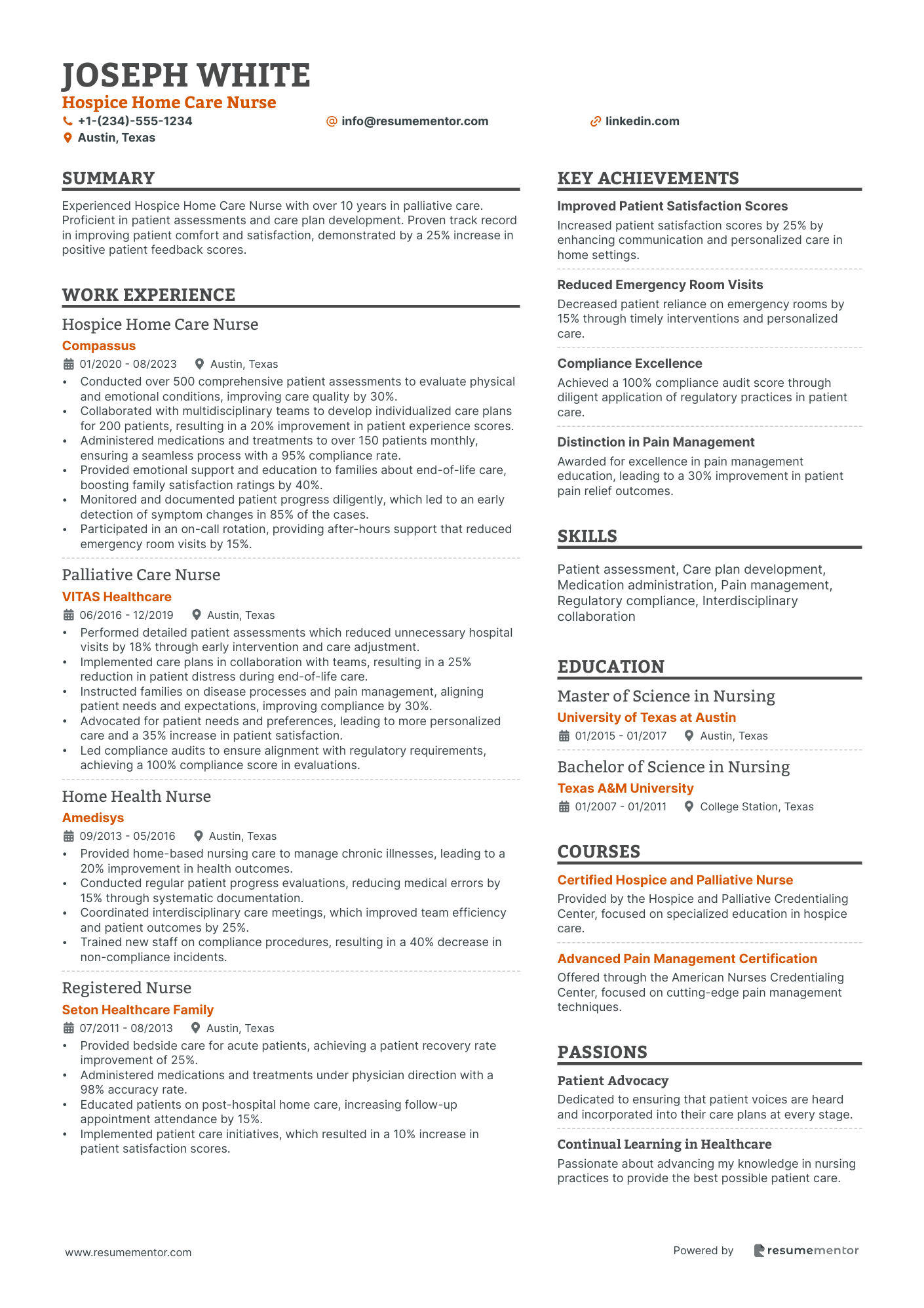
Hospice Home Care Nurse
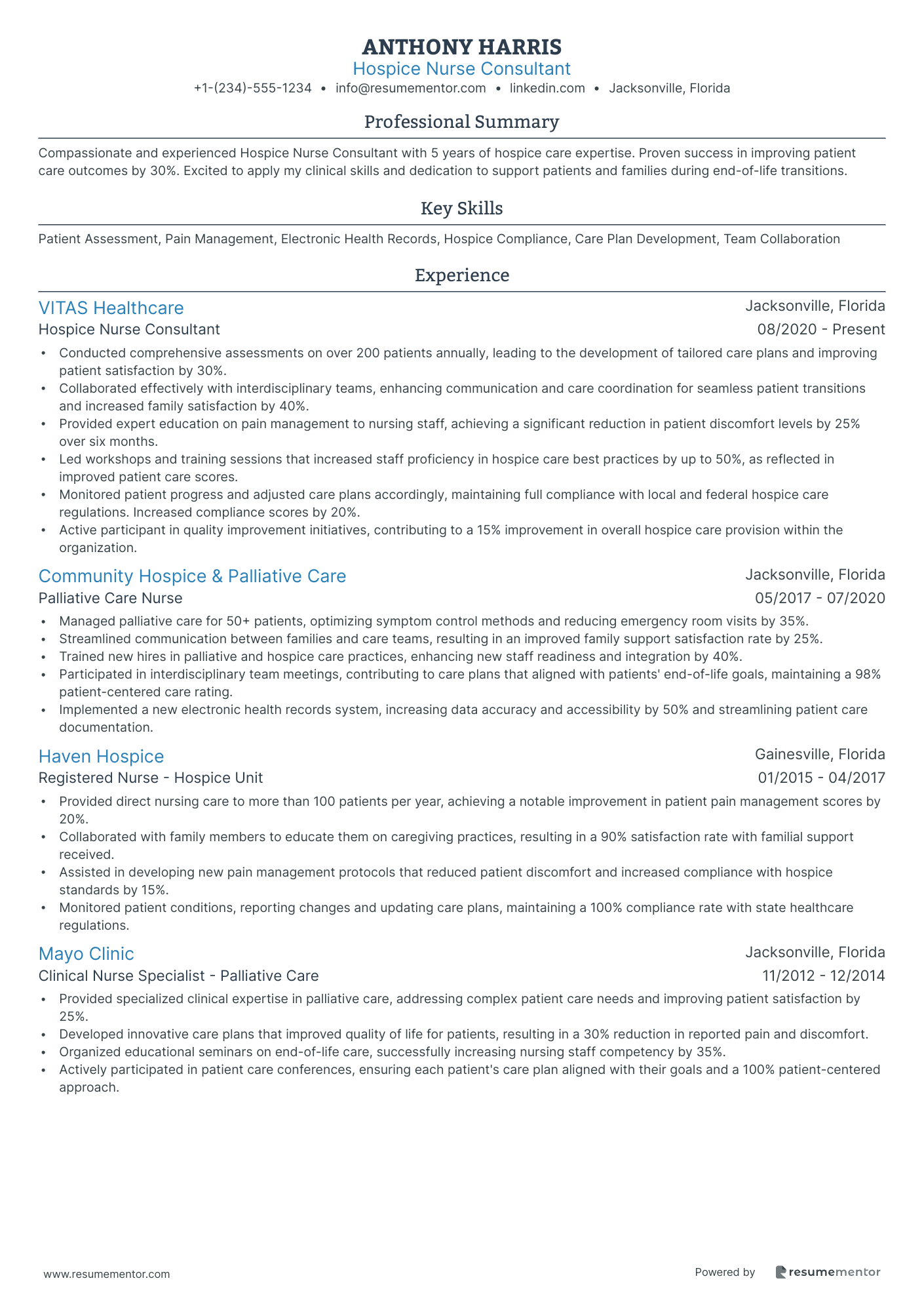
Hospice Nurse Consultant
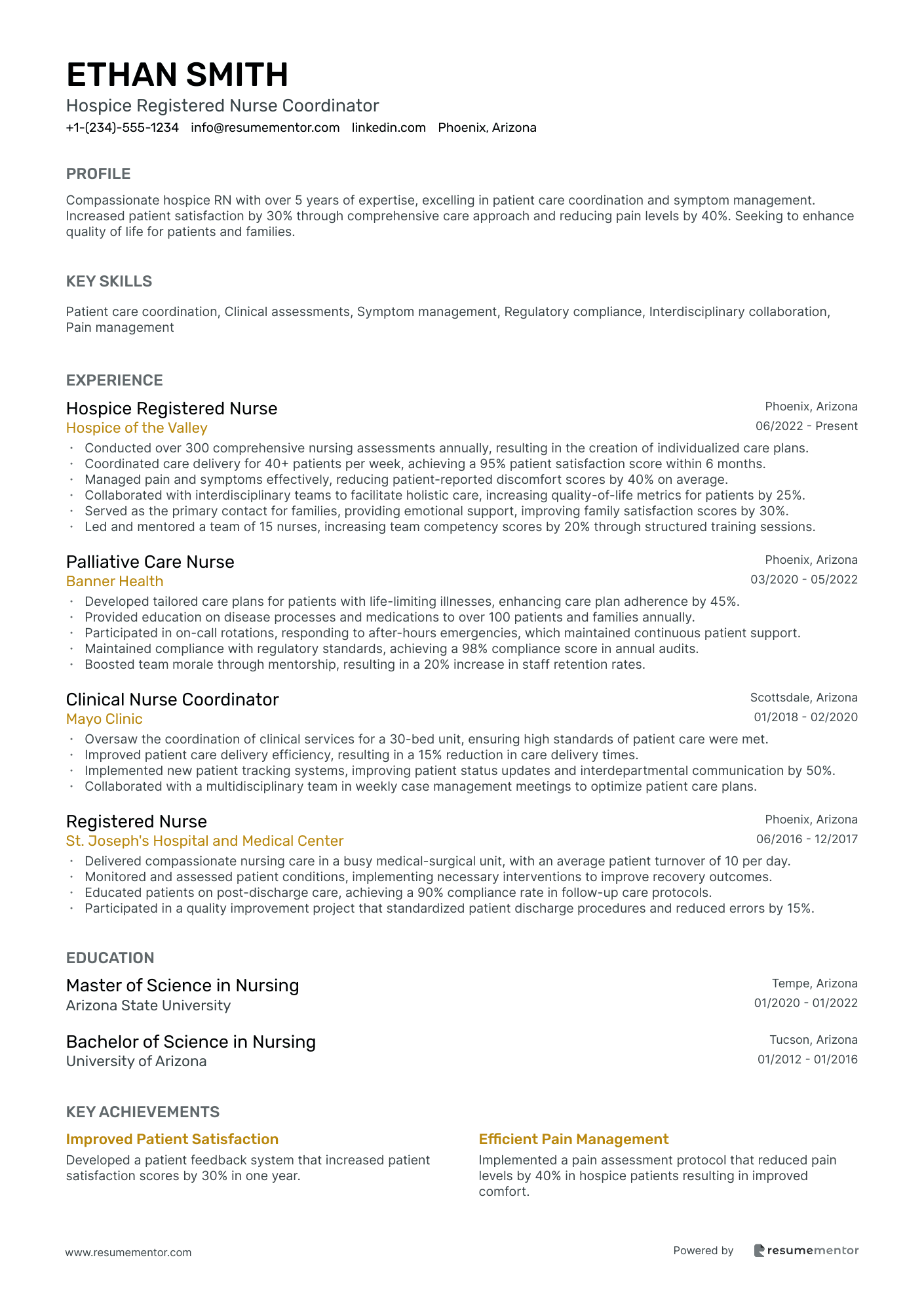
Hospice Registered Nurse Coordinator
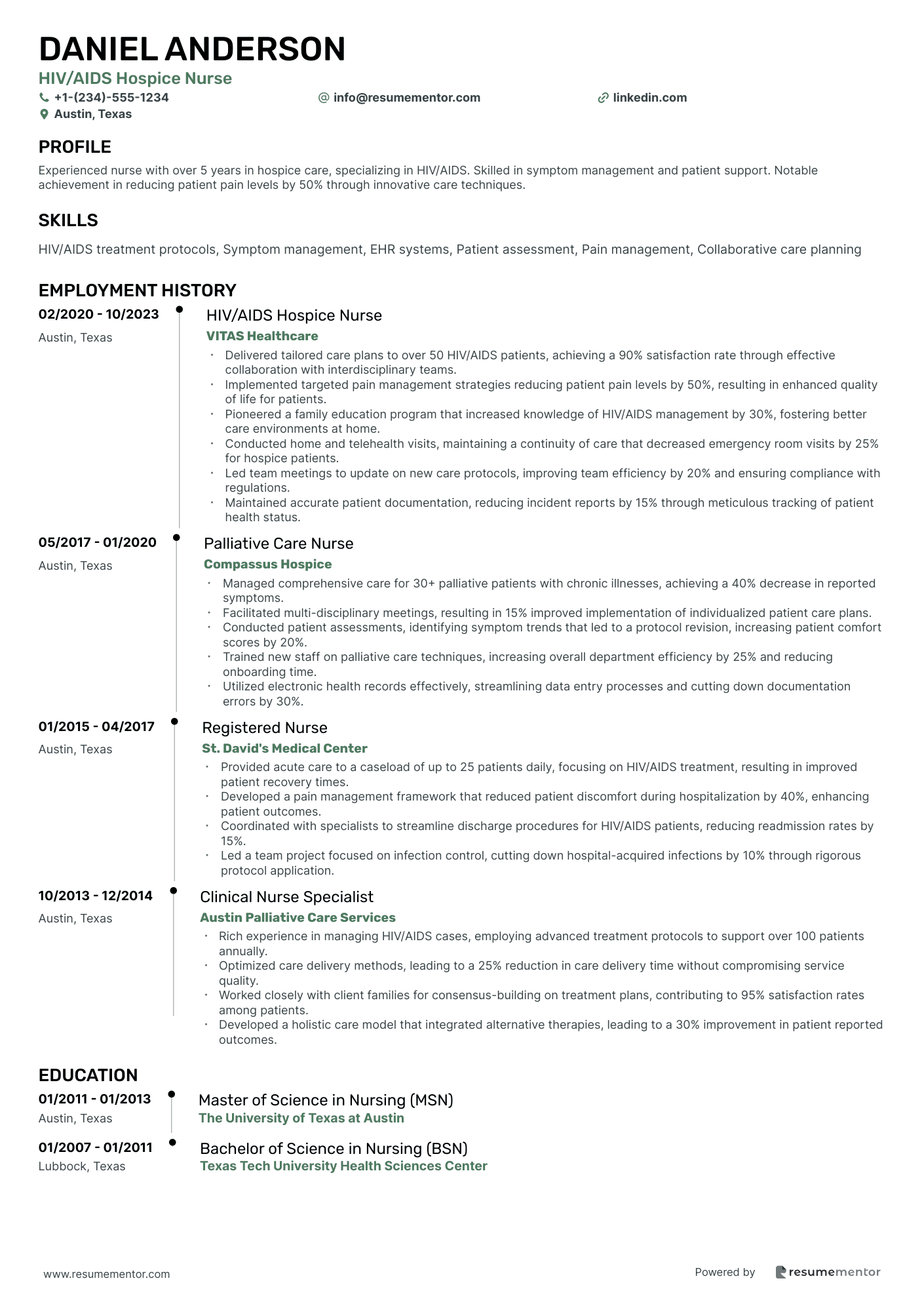
HIV/AIDS Hospice Nurse

Pediatric Hospice Nurse resume sample
- •Developed individualized care plans for over 50 pediatric hospice patients, significantly improving family satisfaction scores by 30%.
- •Administered complex treatments and supervised medication management, resulting in a decrease of 20% in adverse reactions.
- •Trained families on effective symptom management, leading to a 90% compliance rate with personalized care strategies.
- •Collaborated with an interdisciplinary team to optimize holistic care, improving health outcomes by 25%.
- •Maintained precise and timely medical records achieving 100% compliance with healthcare regulations.
- •Led a team initiative to incorporate new palliative care practices, which resulted in a 15% increase in care effectiveness.
- •Provided compassionate care to pediatric patients in a critical care unit, improving patient comfort by 40%.
- •Executed flaw-free patient assessments, reducing turnaround time for care plan adjustments by 25%.
- •Educated 30+ families monthly on disease management and prevention, enhancing family engagement by 20%.
- •Led regular simulation trainings for over 50 nursing peers, enhancing team readiness and reducing emergency response times.
- •Coordinated with multidisciplinary teams to introduce innovative care modules, consequently improving overall patient satisfaction scores.
- •Managed personalized care for homebound patients, significantly aiding the recovery process with a 35% improvement in health outcomes.
- •Successfully reduced hospital readmission rates by 20% through proactive health education and monitoring.
- •Built strong patient relationships resulting in a 95% patient retention rate through demonstrable empathy and effective communication.
- •Conducted over 50 educational workshops for family caregivers, improving competency by 30% in care strategies.
- •Ensured safe delivery of care in a high-pressure acute care setting, leading to zero errors in medication administration.
- •Collaborated with surgeons and specialists to deliver seamless post-surgical care, reducing complication rates by 15%.
- •Contributed to a hospital-wide quality improvement project, resulting in a 10% enhancement in overall patient care standards.
- •Led patient education sessions that facilitated 40% faster patient recovery and reduced the length of hospital stay.
Oncology Hospice Nurse resume sample
- •Provided individualized palliative care to 200 patients with terminal illnesses, resulting in a 25% improvement in pain management outcomes.
- •Collaborated with a multidisciplinary team to develop tailored care plans, significantly enhancing patient comfort and quality of life.
- •Educated over 100 families on hospice care processes and end-of-life options, improving understanding and satisfaction by 30%.
- •Led weekly interdisciplinary team meetings, effectively coordinating care strategies for cancer patients, boosting team efficiency by 20%.
- •Streamlined medication management protocols, reducing prescription errors by 15% and ensuring adherence to regulatory standards.
- •Initiated new patient education programs, resulting in a 40% increase in patient and family engagement in care decisions.
- •Managed complex chemotherapy regimens for a caseload of 50 oncology patients, achieving a zero-error rate in administration procedures.
- •Conducted comprehensive assessments, prompting timely symptom control interventions, reducing hospital visits by 15%.
- •Mentored new oncology nurses, significantly enhancing their proficiency in patient care and contributing to a 25% reduction in training time.
- •Developed patient support workshops focusing on mental health, which were attended by over 150 families, receiving positive feedback.
- •Contributed to research on new pain management techniques, enhancing patient comfort levels by 20% in clinical trials.
- •Provided compassionate end-of-life care to 75 patients annually, ensuring dignity and comfort through effective symptom management.
- •Implemented electronic health records system updates, improving documentation accuracy and reducing administrative errors by 10%.
- •Facilitated bereavement support groups, aiding in emotional support for over 50 grieving families, resulting in improved coping outcomes.
- •Collaborated with chaplains and social workers to provide holistic patient care, significantly enhancing the overall patient experience.
- •Managed a diverse patient portfolio in oncology and palliative settings, ensuring seamless care delivery to over 100 patients.
- •Excelled in IV therapy management, reducing complications by 10% through meticulous protocol adherence and patient education.
- •Spearheaded quality assurance projects, contributing to a 5% increase in patient satisfaction scores within oncology units.
- •Provided direct patient care, achieving a patient satisfaction rate of above 90% in feedback surveys for consistent compassionate care.
Geriatric Hospice Nurse resume sample
- •Developed and implemented personalized care plans leading to a 25% increase in patient satisfaction ratings.
- •Administered medication and monitored for effectiveness, reducing adverse effects by 15% through vigilant assessment.
- •Provided emotional counseling to families, resulting in a 30% improvement in family support feedback scores.
- •Led interdisciplinary team meetings, ensuring holistic care approaches which improved collaboration by 40% among departments.
- •Educated 150+ patients and families on hospice options and community resources, enhancing understanding and comfort care.
- •Monitored patient progress with detailed documentation, identifying critical changes, leading to timely interventions in 85% of cases.
- •Assessed patient needs effectively, leading to tailored care plans and a 20% reduction in emergency admissions.
- •Administered treatments as prescribed, achieving a 95% medication accuracy rate through thorough checks and balances.
- •Collaborated with social workers and chaplains, increasing patient holistic care experiences by 35% in satisfaction surveys.
- •Enhanced hospice education for families, boosting knowledge retention rates by 45% with informative workshops.
- •Monitored and reported significant condition changes, resulting in proactive care adjustments for 70% of patients.
- •Provided geriatric care to 100+ patients, focusing on dignity and compassion, resulting in positive patient reviews.
- •Educated staff on geriatric best practices, enhancing department-wide care standards and reducing readmission rates by 15%.
- •Administered and monitored medications, achieving a consistent 0% medication error rate over two years.
- •Facilitated family support group meetings, improving family involvement and understanding of patient care by 25%.
- •Cared for diverse patient populations, honing skills in comprehensive assessment and diagnosis, leading to improved patient outcomes.
- •Assisted in developing patient care procedures, enhancing department efficiency by 20% and reducing wait times significantly.
- •Collaborated with healthcare teams to bridge care gaps, resulting in a patient care improvement by 35% through integrated approaches.
- •Conducted patient education to improve adherence to treatment plans, successfully raising compliance by 30%.
Palliative Care Hospice Nurse resume sample
- •Conducted detailed assessments of patients' needs, leading to a 30% improvement in care plan accuracy and effectiveness.
- •Developed individualized care strategies in collaboration with a multidisciplinary team, enhancing patient comfort by 25%.
- •Successfully managed patient symptoms, reducing pain by 40% using evidence-based interventions.
- •Facilitated more than 100 family education sessions yearly, improving understanding of palliative care options and patient outcomes.
- •Improved interdisciplinary communication, reducing response times on patient care actions by 15%.
- •Streamlined documentation processes, cutting time spent on paperwork by 20%, resulting in greater focus on patient interaction.
- •Managed a caseload of 30 hospice patients, ensuring personalized care plans and adherence to patients' needs and preferences.
- •Administered medication and supervised treatments for improved symptom management, resulting in better patient comfort and care quality.
- •Collaborated with healthcare teams in case conferences, successfully resolving 85% of patient care issues within 24 hours.
- •Implemented family support services that increased patient family satisfaction scores by 18%.
- •Participated in ongoing education seminars, expanding team knowledge on new hospice and palliative care practices.
- •Conducted in-home patient assessments, improving care plans and enhancing patient satisfaction by 15%.
- •Successfully administered wound care treatments that decreased infection rates among home care patients by 20%.
- •Promoted patient autonomy through education, resulting in a 20% increase in patient management of at-home care procedures.
- •Advanced team collaboration by integrating telehealth tools, reducing unnecessary hospital visits by 10%.
- •Coordinated care for a diverse patient population on a medical-surgical unit, improving patient outcomes consistently over 18 months.
- •Monitored patient progress utilizing hospital protocols, significantly reducing readmission rates by 12%.
- •Trained new staff on best practices and protocols, leading to a 15% improvement in nursing proficiency within the unit.
- •Integrated palliative care principles into patient management plans, enhancing the overall patient experience.
Hospice Nurse Case Manager resume sample
- •Performed comprehensive assessments of 100+ hospice patients annually, developing tailored care plans that improved comfort and quality of life.
- •Collaborated with a multidisciplinary team resulting in a 15% reduction of unnecessary hospitalizations by proactively managing patient symptoms.
- •Enhanced patient outcomes through accurate documentation and regulatory compliance, achieving a 98% audit success rate.
- •Educated families and patients on hospice options, increasing enrollment satisfaction scores by 25%.
- •Coordinated over 300 in-home visits per year, optimizing care delivery and resource allocation to meet patient needs.
- •Led monthly case conferences, contributing essential insights that led to strategic care plan refinements.
- •Implemented patient-centered palliative care plans, resulting in a 30% increase in patient satisfaction scores.
- •Facilitated seamless communication across 20+ healthcare professionals, ensuring holistic patient support.
- •Managed the use of EMR systems effectively, enhancing data accuracy and care coordination.
- •Assessed and adapted care strategies for terminally ill patients, directly improving symptom control and quality of life.
- •Advocated for patient care preferences, ensuring alignment with family objectives and ethical standards.
- •Provided end-of-life care and education to patients and their families in a high-stress ICU setting.
- •Developed proficiency in EMR systems, increasing workflow efficiency by 20%.
- •Participated in patient care planning for critically ill patients, improving discharge processes.
- •Enhanced team collaboration, which led to an optimized 15% increase in departmental performance.
- •Conducted in-home patient assessments, managing complex care plans for 50+ patients.
- •Trained in-home caregivers, increasing care continuity and reducing emergencies by 10%.
- •Documented patient progress accurately, complying with agency and regulatory standards.
- •Executed patient education initiatives, improving adherence to care regimens.
Certified Hospice and Palliative Nurse (CHPN) resume sample
- •Led interdisciplinary teams to develop personalized care plans for over 100 patients, enhancing patient comfort and care satisfaction significantly.
- •Improved patient symptom management through development and implementation of effective medication protocols, boosting care quality ratings.
- •Conducted extensive patient and family education sessions on palliative care options, increasing understanding and compliance by 30%.
- •Played key role in implementing electronic documentation systems, reducing documentation errors by over 40% and improving compliance.
- •Coordinated care among different departments to ensure seamless patient transitions, significantly enhancing care continuity for over 90% of patients.
- •Collaborated with care teams to advocate for patient preferences, achieving a 20% increase in care satisfaction scores.
- •Managed care for over 75 patients, resulting in a 25% increase in patient satisfaction scores through comprehensive care plans.
- •Devised and executed educational programs for families, significantly enhancing their understanding of disease processes and care options.
- •Facilitated weekly interdisciplinary team meetings with a focus on care improvement, contributing to a 15% rise in quality metrics.
- •Performed comprehensive assessments for new patients, ensuring treatment plans were tailored to individual needs and improved outcomes.
- •Reduced average medication errors by 35% through diligent review processes and robust safety protocols.
- •Provided specialized care to terminally ill patients, resulting in a 40% improvement in comfort levels and quality of life.
- •Led patient advocacy initiatives, ensuring patient wishes were central to care decisions and improved patient autonomy.
- •Trained and mentored new nursing staff, which enhanced team performance by 30% and reduced onboarding time.
- •Utilized clinical assessment skills to manage complex cases effectively, leading to improved care outcomes for over 50 patients.
- •Delivered compassionate care and support to end-of-life patients, achieving a 20% boost in patient satisfaction scores.
- •Worked collaboratively with interdisciplinary teams, improving care coordination and patient outcome metrics by 15%.
- •Conducted ongoing evaluations and modifications of care plans, significantly improving patient comfort and satisfaction.
- •Effectively communicated complex medical information to patients and families, enhancing their understanding and participation in care.
Hospice Home Care Nurse resume sample
- •Conducted over 500 comprehensive patient assessments to evaluate physical and emotional conditions, improving care quality by 30%.
- •Collaborated with multidisciplinary teams to develop individualized care plans for 200 patients, resulting in a 20% improvement in patient experience scores.
- •Administered medications and treatments to over 150 patients monthly, ensuring a seamless process with a 95% compliance rate.
- •Provided emotional support and education to families about end-of-life care, boosting family satisfaction ratings by 40%.
- •Monitored and documented patient progress diligently, which led to an early detection of symptom changes in 85% of the cases.
- •Participated in an on-call rotation, providing after-hours support that reduced emergency room visits by 15%.
- •Performed detailed patient assessments which reduced unnecessary hospital visits by 18% through early intervention and care adjustment.
- •Implemented care plans in collaboration with teams, resulting in a 25% reduction in patient distress during end-of-life care.
- •Instructed families on disease processes and pain management, aligning patient needs and expectations, improving compliance by 30%.
- •Advocated for patient needs and preferences, leading to more personalized care and a 35% increase in patient satisfaction.
- •Led compliance audits to ensure alignment with regulatory requirements, achieving a 100% compliance score in evaluations.
- •Provided home-based nursing care to manage chronic illnesses, leading to a 20% improvement in health outcomes.
- •Conducted regular patient progress evaluations, reducing medical errors by 15% through systematic documentation.
- •Coordinated interdisciplinary care meetings, which improved team efficiency and patient outcomes by 25%.
- •Trained new staff on compliance procedures, resulting in a 40% decrease in non-compliance incidents.
- •Provided bedside care for acute patients, achieving a patient recovery rate improvement of 25%.
- •Administered medications and treatments under physician direction with a 98% accuracy rate.
- •Educated patients on post-hospital home care, increasing follow-up appointment attendance by 15%.
- •Implemented patient care initiatives, which resulted in a 10% increase in patient satisfaction scores.
Hospice Nurse Consultant resume sample
- •Conducted comprehensive assessments on over 200 patients annually, leading to the development of tailored care plans and improving patient satisfaction by 30%.
- •Collaborated effectively with interdisciplinary teams, enhancing communication and care coordination for seamless patient transitions and increased family satisfaction by 40%.
- •Provided expert education on pain management to nursing staff, achieving a significant reduction in patient discomfort levels by 25% over six months.
- •Led workshops and training sessions that increased staff proficiency in hospice care best practices by up to 50%, as reflected in improved patient care scores.
- •Monitored patient progress and adjusted care plans accordingly, maintaining full compliance with local and federal hospice care regulations. Increased compliance scores by 20%.
- •Active participant in quality improvement initiatives, contributing to a 15% improvement in overall hospice care provision within the organization.
- •Managed palliative care for 50+ patients, optimizing symptom control methods and reducing emergency room visits by 35%.
- •Streamlined communication between families and care teams, resulting in an improved family support satisfaction rate by 25%.
- •Trained new hires in palliative and hospice care practices, enhancing new staff readiness and integration by 40%.
- •Participated in interdisciplinary team meetings, contributing to care plans that aligned with patients' end-of-life goals, maintaining a 98% patient-centered care rating.
- •Implemented a new electronic health records system, increasing data accuracy and accessibility by 50% and streamlining patient care documentation.
- •Provided direct nursing care to more than 100 patients per year, achieving a notable improvement in patient pain management scores by 20%.
- •Collaborated with family members to educate them on caregiving practices, resulting in a 90% satisfaction rate with familial support received.
- •Assisted in developing new pain management protocols that reduced patient discomfort and increased compliance with hospice standards by 15%.
- •Monitored patient conditions, reporting changes and updating care plans, maintaining a 100% compliance rate with state healthcare regulations.
- •Provided specialized clinical expertise in palliative care, addressing complex patient care needs and improving patient satisfaction by 25%.
- •Developed innovative care plans that improved quality of life for patients, resulting in a 30% reduction in reported pain and discomfort.
- •Organized educational seminars on end-of-life care, successfully increasing nursing staff competency by 35%.
- •Actively participated in patient care conferences, ensuring each patient's care plan aligned with their goals and a 100% patient-centered approach.
Hospice Registered Nurse Coordinator resume sample
- •Conducted over 300 comprehensive nursing assessments annually, resulting in the creation of individualized care plans.
- •Coordinated care delivery for 40+ patients per week, achieving a 95% patient satisfaction score within 6 months.
- •Managed pain and symptoms effectively, reducing patient-reported discomfort scores by 40% on average.
- •Collaborated with interdisciplinary teams to facilitate holistic care, increasing quality-of-life metrics for patients by 25%.
- •Served as the primary contact for families, providing emotional support, improving family satisfaction scores by 30%.
- •Led and mentored a team of 15 nurses, increasing team competency scores by 20% through structured training sessions.
- •Developed tailored care plans for patients with life-limiting illnesses, enhancing care plan adherence by 45%.
- •Provided education on disease processes and medications to over 100 patients and families annually.
- •Participated in on-call rotations, responding to after-hours emergencies, which maintained continuous patient support.
- •Maintained compliance with regulatory standards, achieving a 98% compliance score in annual audits.
- •Boosted team morale through mentorship, resulting in a 20% increase in staff retention rates.
- •Oversaw the coordination of clinical services for a 30-bed unit, ensuring high standards of patient care were met.
- •Improved patient care delivery efficiency, resulting in a 15% reduction in care delivery times.
- •Implemented new patient tracking systems, improving patient status updates and interdepartmental communication by 50%.
- •Collaborated with a multidisciplinary team in weekly case management meetings to optimize patient care plans.
- •Delivered compassionate nursing care in a busy medical-surgical unit, with an average patient turnover of 10 per day.
- •Monitored and assessed patient conditions, implementing necessary interventions to improve recovery outcomes.
- •Educated patients on post-discharge care, achieving a 90% compliance rate in follow-up care protocols.
- •Participated in a quality improvement project that standardized patient discharge procedures and reduced errors by 15%.
HIV/AIDS Hospice Nurse resume sample
- •Delivered tailored care plans to over 50 HIV/AIDS patients, achieving a 90% satisfaction rate through effective collaboration with interdisciplinary teams.
- •Implemented targeted pain management strategies reducing patient pain levels by 50%, resulting in enhanced quality of life for patients.
- •Pioneered a family education program that increased knowledge of HIV/AIDS management by 30%, fostering better care environments at home.
- •Conducted home and telehealth visits, maintaining a continuity of care that decreased emergency room visits by 25% for hospice patients.
- •Led team meetings to update on new care protocols, improving team efficiency by 20% and ensuring compliance with regulations.
- •Maintained accurate patient documentation, reducing incident reports by 15% through meticulous tracking of patient health status.
- •Managed comprehensive care for 30+ palliative patients with chronic illnesses, achieving a 40% decrease in reported symptoms.
- •Facilitated multi-disciplinary meetings, resulting in 15% improved implementation of individualized patient care plans.
- •Conducted patient assessments, identifying symptom trends that led to a protocol revision, increasing patient comfort scores by 20%.
- •Trained new staff on palliative care techniques, increasing overall department efficiency by 25% and reducing onboarding time.
- •Utilized electronic health records effectively, streamlining data entry processes and cutting down documentation errors by 30%.
- •Provided acute care to a caseload of up to 25 patients daily, focusing on HIV/AIDS treatment, resulting in improved patient recovery times.
- •Developed a pain management framework that reduced patient discomfort during hospitalization by 40%, enhancing patient outcomes.
- •Coordinated with specialists to streamline discharge procedures for HIV/AIDS patients, reducing readmission rates by 15%.
- •Led a team project focused on infection control, cutting down hospital-acquired infections by 10% through rigorous protocol application.
- •Rich experience in managing HIV/AIDS cases, employing advanced treatment protocols to support over 100 patients annually.
- •Optimized care delivery methods, leading to a 25% reduction in care delivery time without compromising service quality.
- •Worked closely with client families for consensus-building on treatment plans, contributing to 95% satisfaction rates among patients.
- •Developed a holistic care model that integrated alternative therapies, leading to a 30% improvement in patient reported outcomes.
Navigating the world of resume writing can feel like uncharted waters for a hospice nurse. While you're skilled in providing comfort and compassion during life's toughest moments, translating that experience into a resume can be challenging. You may wonder how to effectively convey your unique skills and the profound impact you've made on patients and their families.
It's crucial to clearly highlight your medical expertise and empathy. Showcasing your ability to work under pressure while maintaining a caring touch is essential. Yet, crafting a compelling resume that reflects these strengths doesn’t have to be daunting.
Starting with a resume template provides helpful guidance. Using a structured template ensures you include all vital information and present your qualifications in a clear, professional manner. This makes it easier to focus on expressing your dedication and skills to potential employers without missing any critical details.
In hospice care, every detail matters, from your clinical skills to the emotional support you provide. Accurately reflecting these elements on your resume positions you more effectively in the job market. Embrace this process with confidence, knowing that your resume is the key to unlocking new opportunities.
Key Takeaways
- Highlight your compassionate care skills and medical expertise while focusing on emotional support and effective communication in hospice nursing.
- Use a structured resume template to include all vital information, such as contact details, professional summary, skills, work experience, education, and certifications.
- Choose a reverse-chronological format with modern fonts like Raleway or Lato and save as a PDF to maintain formatting consistency.
- Include quantifiable achievements and specific responsibilities in the experience section to showcase your contributions and skills.
- Emphasize both hard skills like patient care and palliative techniques, and soft skills such as empathy and communication, to create a comprehensive and keyword-rich resume.
What to focus on when writing your hospice nurse resume
A hospice nurse resume should clearly communicate your compassionate care skills and medical expertise to the recruiter. It should reflect your ability to support terminally ill patients and their families with empathy and proficiency. Your strengths in providing emotional support, effective communication, and symptom management are vital in hospice care.
How to structure your hospice nurse resume
- Contact Information — Start by including your full name, phone number, email address, and LinkedIn profile. This section is crucial because it not only identifies you but also provides the best ways for potential employers to reach you. Placing it at the top ensures it's prominent and immediately accessible, setting the stage for the rest of your resume.
- Professional Summary — Follow with a concise statement that captures your experience in hospice care. Here, you should highlight your empathy for patients and dedication to quality end-of-life care. Incorporating specific metrics, such as years of experience or the number of patients served, can make your summary stand out, offering an impactful snapshot of your career achievements right at the start.
- Skills — Next, emphasize skills integral to hospice care like palliative care, pain management, family support, and patient education. In this section, it's beneficial to consider the unique challenges and requirements of hospice nursing, showcasing abilities that directly contribute to improving patient outcomes. Adding relevant certifications like CPR or ACLS not only strengthens your candidacy but also demonstrates your commitment to maintaining current, applicable skills.
- Work Experience — In the work experience section, it’s helpful to list your previous roles in reverse chronological order. Detailing your responsibilities and achievements with specific numbers, such as "improved patient comfort scores by 20%," can effectively demonstrate your impact. This section is where you show the real-world application of your skills, reminding recruiters of your capacity to deliver on the essential duties of a hospice nurse.
- Education — Transitioning into education, include your nursing degree and any specialized training in hospice or palliative care. Don’t forget to mention the state where you're licensed as an RN. Your educational background serves as the foundation for your professional expertise, supporting the skills and experiences you've outlined in previous sections.
- Certifications and Licenses — Wrapping up, highlight essential hospice nursing certifications like Certified Hospice and Palliative Nurse (CHPN) to showcase your qualifications. This section underlines your commitment to professional development and ensures you meet industry standards for competence and quality.
Adding optional sections such as Volunteer Experience and Awards can further illustrate your dedication and excellence in hospice care, rounding out a compelling resume. With a clear understanding of the overall structure, let's now delve deeper into each section to maximize your resume's impact, exploring the best format to achieve an ATS-friendly result.
Which resume format to choose
Crafting a resume for a hospice nurse is all about blending your technical skills with the compassion that defines your profession. Using a reverse-chronological format is key, as this layout showcases your most recent experiences first. Employers in the healthcare sector often focus on your recent roles to assess how your skills have evolved, making this format particularly effective.
Your font choice also matters in conveying professionalism. Opt for modern fonts like Raleway, Lato, or Montserrat. These fonts offer a balance of professionalism and readability, which is essential when you need your resume to make a good impression quickly.
Equally crucial is choosing the right file type to maintain your resume's integrity. Save it as a PDF to ensure your formatting remains consistent, no matter what device or software is used to view it. Consistency in presentation tells employers that attention to detail is a priority for you—a quality vital in healthcare settings.
Consider the margins too, as they affect the overall readability of your resume. Stick to standard one-inch margins. This provides ample white space, giving your content room to breathe and making it easier for employers to absorb important information at a glance.
Integrating these elements is key to crafting a resume that not only appears polished but also effectively communicates your qualifications in the field of hospice nursing. This approach ensures that your resume stands out for its professionalism and clarity, reflecting your dedication to your career.
How to write a quantifiable resume experience section
Creating a hospice nurse resume experience section means focusing on specific achievements and responsibilities that highlight your skills and past excellence. This section is vital because it showcases your ability to handle challenges similar to what future employers might present. Start each entry with your job title, followed by the workplace name, location, and date range, and limit your history to the past ten to fifteen years, concentrating on hospice-related roles.
Enhancing your resume by tailoring it to the job description can significantly boost your chances of success. Use language and keywords from the job posting to navigate applicant tracking systems effectively. Choose impactful action words like “collaborated,” “improved,” and “managed” to emphasize your contributions. Highlight quantifiable achievements like improvements in patient satisfaction scores or care procedures that you have initiated.
Here is a hospice nurse resume experience example:
- •Improved patient care plans, resulting in a 20% increase in patient comfort and satisfaction scores.
- •Led a team of 10 nursing staff, enhancing collaboration and reducing turnover by 15%.
- •Developed a new pain management protocol, decreasing medication errors by 30%.
- •Educated over 100 families on end-of-life care, resulting in higher family satisfaction ratings.
This experience section stands out because it’s finely tailored to underline skills essential in hospice care. Clear job titles and locations reinforce recent experience relevant to prospective employers. Utilizing strong action verbs highlights your leadership and significant improvements you’ve driven. Each bullet point details quantifiable successes, showcasing your capacity to enhance patient care and team dynamics while implementing effective care protocols, reinforcing your value as a candidate.
Result-Focused resume experience section
A result-focused hospice nurse resume experience section should effectively highlight the impact you’ve had in your role. Begin by clearly stating the timeframe of your employment and then delve into how your actions and skills benefited both patients and the workplace. It’s important to illustrate how your unique approaches enhanced patient care and supported the hospice team, showcasing the meaningful differences you've made in the lives of your patients and colleagues.
Utilize bullet points to present your achievements in a clear and engaging manner, which allows hiring managers to easily understand the value you bring. Initiate each point with a compelling action verb and incorporate quantifiable results whenever possible. This approach provides prospective employers with a vivid picture of your potential contributions to their organization. Rather than relying on vague statements, offer specific examples that illustrate how you improved patient care, tackled challenges, and collaborated effectively with your team.
Hospice Nurse
Compassionate Care Hospice
June 2018 - September 2023
- Enhanced patient comfort through personalized pain management plans, boosting satisfaction scores by 20%
- Led a team of 4 caregivers in transitioning to electronic health records, cutting documentation errors by 15%
- Educated family members on end-of-life care, raising positive feedback on family support by 25%
- Implemented a new symptom management protocol, reducing emergency hospital visits by 18%
Leadership-Focused resume experience section
A leadership-focused hospice nurse resume experience section should clearly demonstrate your ability to guide teams and improve patient care. Begin by showcasing key moments where your leadership made a difference in patient outcomes or team effectiveness. Use action-oriented language to explain how you improved processes, and led your team through challenges, emphasizing the tangible outcomes your leadership achieved, such as improved patient satisfaction or enhanced team productivity.
In your bullet points, focus on responsibilities that highlight your leadership skills, such as coordinating patient care plans, mentoring staff, or managing multidisciplinary teams. Quantifying these achievements will help illustrate the value you bring. Keep the emphasis on your leadership qualities and the positive changes they inspired within your organization. Here's an example of how it can look:
Hospice Nurse Manager
Sunshine Hospice Care
June 2018 - Present
- Managed a team of 10 hospice nurses, improving overall patient satisfaction scores by 20%.
- Implemented a mentorship program that reduced nurse turnover by 15%.
- Led interdisciplinary meetings to develop tailored care plans, boosting efficiency by 30%.
- Launched a patient feedback initiative, resulting in a 25% increase in positive reviews.
Technology-Focused resume experience section
A technology-focused hospice nurse resume experience section should effectively blend your nursing expertise with your ability to use technological tools. Start by identifying specific systems or applications that enhance the efficiency of hospice care, whether through improving patient records, aiding communication, or simplifying administrative tasks. Describe how these tools contribute to better patient outcomes, highlighting your role in integrating technology into compassionate care. This strategy appeals to employers looking for professionals who can navigate both healthcare and technology.
Clearly outline your responsibilities and achievements using bullet points in your resume. Ensure each point showcases your proficiency with technology in a hospice environment. Begin with strong action verbs and provide details about the specific technologies or software you have used. By demonstrating your tech skills alongside your clinical experience, you present a comprehensive view of your capabilities, emphasizing both adaptability and dedication to delivering quality care.
Hospice Nurse
Caring Hearts Hospice
June 2020 - Present
- Implemented electronic health records (EHR) to improve patient care accuracy and access.
- Utilized telehealth platforms to conduct virtual visits, increasing patient access during remote care situations.
- Tracked patient medication electronically to ensure timely administration and alleviate human error.
- Streamlined communication with team members through digital scheduling and messaging apps to enhance collaborative care.
Collaboration-Focused resume experience section
A collaboration-focused hospice nurse resume experience section should highlight your ability to work seamlessly with others to improve patient care. Start by stating your role, workplace, and time frame of employment, setting the stage for your story of teamwork and impact. Describe specific instances where you partnered with doctors to create tailored care plans or teamed up with families to navigate the complexities of end-of-life care. Your skills in maintaining open communication among diverse groups emphasize your vital role as a patient and family advocate.
Rather than merely listing tasks, focus on how your collaborative efforts have contributed to team success and enhanced patient outcomes. Share examples of projects or initiatives where teamwork led to improvements, like boosting care quality or enhancing organizational efficiency. In the bullet points, use action words such as "collaborated," "coordinated," and "facilitated" to highlight your active role and the direct impact of your efforts. This approach clearly demonstrates how your ability to work well with others results in exceptional care and a positive experience for patients and their families.
Hospice Nurse
Sunset Acres Hospice Care Center
June 2018 - Present
- Collaborated with interdisciplinary teams to develop personalized care plans, enhancing patient comfort and well-being.
- Facilitated family meetings to align on care goals, providing clear communication to ensure a shared understanding.
- Coordinated with home health aides to optimize resource allocation, ensuring effective and timely patient interventions.
- Led workshops for staff on communication best practices, improving team dynamics and patient satisfaction scores.
Write your hospice nurse resume summary section
A hospice-focused nurse resume should capture empathy and expertise right from the summary section. When writing this part of your resume, emphasize your experience, skills, and passion. Use clear and simple language to highlight what makes you stand out as a caregiver. A strong resume summary succinctly shares your career highlights and conveys your future goals. Consider the unique qualities you bring to hospice care—perhaps it’s your compassion, strong communication skills, or years of dedicated service to patients. Here's how you can craft a summary that truly captures attention:
This summary is effective because it outlines your significant experience, specialized skills, and personal attributes. It not only showcases your professional background but also highlights your commitment to dignified patient care. Presenting yourself in this way makes clear what you can offer a potential employer.
Choosing the right words to describe yourself in a resume summary involves balancing your experience with your personal traits. Use definitive language to focus on achievements that demonstrate your capabilities. Understanding the subtle differences between a summary and a resume objective is important for tailoring your application. While a summary highlights your career thus far, showcasing your skills, an objective points to what you hope to achieve in a new role. Similarly, a resume profile is broader, offering a more extended overview of your career, whereas a summary of qualifications is a bullet-point list of your top achievements. These distinctions can guide you in crafting an effective resume.
Listing your hospice nurse skills on your resume
A skills-focused hospice nurse resume should seamlessly integrate your competencies throughout all sections. You can highlight skills as a dedicated section or weave them into your experience and summary. Your strengths and soft skills are vital; these are the personal qualities and interpersonal abilities that enhance your patient care. Meanwhile, hard skills are the specific technical capabilities you need to perform your job effectively.
Think of your skills and strengths as powerful keywords for your resume. They not only highlight your qualifications but also make your resume more noticeable to employers and applicant tracking systems. Here's what a standalone skills section may look like:
This section effectively captures the essential capabilities you possess as a hospice nurse, demonstrating your readiness to manage key responsibilities.
Best hard skills to feature on your hospice nurse resume
Demonstrating technical competence through your hard skills is crucial. These skills prove you have the expertise to deliver compassionate care and should include areas such as:
Hard Skills
- Patient Care
- Pain Management
- Palliative Care Techniques
- Medication Administration
- Patient Assessment
- Electronic Health Records (EHR)
- Symptom Management
- Infection Control
- Medical Equipment Management
- Wound Care
- Nursing Protocols
- Crisis Intervention
- Nutrition Support
- Care Plan Development
- Advance Directives Knowledge
Best soft skills to feature on your hospice nurse resume
Your ability to connect personally with patients and families hinges on your soft skills. These skills reflect your capability to communicate and manage situations with empathy and understanding. Essential soft skills to highlight are:
Integrating these guidelines into your resume can effectively convey your strengths and aptitude as a hospice nurse.
Soft Skills
- Empathy
- Communication
- Compassion
- Patient Advocacy
- Team Collaboration
- Emotional Resilience
- Problem-Solving
- Multitasking
- Attention to Detail
- Interpersonal Skills
- Cultural Sensitivity
- Active Listening
- Stress Management
- Patience
- Adaptability
How to include your education on your resume
Your education section is an important part of your hospice nurse resume. It showcases your qualifications and provides insight into your academic background. A well-crafted education section should be tailored specifically to the job you are seeking. Only include relevant education that supports your application for a hospice nurse position—omit any unrelated academic experiences.
When including your GPA, only list it if it enhances your resume, typically if it's above a 3.5. If you graduated with honors, such as "cum laude," be sure to include this distinction as it highlights academic achievement. Clearly list your degree, such as "Bachelor of Science in Nursing," along with the institution and year of graduation.
Look at the following examples for clarity:
Now, compare that to a more suitable example:
- •Graduated cum laude
The second example excels because it directly pertains to a nursing career, showcasing a Bachelor of Science in Nursing. Highlighting both the high GPA and "cum laude" distinction demonstrates academic excellence. This example’s format is concise, relevant, and focuses on qualifications critical to the role of a hospice nurse.
How to include hospice nurse certificates on your resume
Including a certificates section in your hospice nurse resume is crucial. This part of your resume shows your qualifications and makes you stand out. List the name of each certificate. Include the date when you earned it. Add the issuing organization. Optionally, you can include your certificates in the header for quick visibility. For example, you might write, “Jane Doe, RN, CHPN” to display your certification right at the top.
This example is good because it lists certifications directly related to hospice care. The title to each certificate is clear. The issuing organizations are respected and known in the healthcare field. This layout makes it easy for employers to verify your qualifications quickly. Adding the certificates helps you show that you are well-prepared for the role.
Extra sections to include in your hospice nurse resume
A hospice nurse is a compassionate professional committed to providing end-of-life care that maintains the dignity and comfort of patients. Your resume should showcase a diverse range of experiences and skills to emphasize your well-rounded capabilities.
Language section — Highlight any additional languages you speak to show your ability to communicate with a diverse patient population. Indicate your proficiency levels to give a clear picture of your language skills.
Hobbies and interests section — Show your personality by listing hobbies related to caregiving or mental wellness. Mention interests that demonstrate patience, compassion, or creativity, which are crucial for a hospice nurse.
Volunteer work section — Include volunteer experiences relevant to your nursing career to highlight your commitment and altruism. List the organizations and your roles to underline your work outside the professional environment.
Books section — List any books you’ve read about patient care or nursing to evidence your continued learning. Mentioning relevant books indicates that you stay updated on best practices and innovations in hospice care.
By following these guidelines, your resume will give a holistic view of your skills and strengths, making you stand out as a candidate who is not only professionally competent but also empathetic and well-rounded.
In Conclusion
In conclusion, writing an effective resume as a hospice nurse can open doors to new opportunities in your career. By emphasizing your medical expertise alongside your compassionate care, you create a strong image of competence and empathy. Starting with a structured template ensures clarity and professionalism, helping you highlight your strengths without missing any key details. Integrating skills like palliative care and patient comfort management not only showcases your capabilities but also differentiates you from other candidates. Including precise metrics and achievements provides tangible evidence of your impact in previous roles. Additionally, a reverse-chronological format allows potential employers to see your most recent and relevant experience first, ensuring your resume captures their attention. Choose modern fonts for readability and attach your resume as a PDF to maintain its format across various devices. Lastly, consider extra sections for volunteer work or relevant books to portray a holistic view of yourself. By following these strategies, you present yourself as a dedicated and well-rounded hospice nurse ready to make a meaningful contribution.
Related Articles

Continue Reading
Check more recommended readings to get the job of your dreams.
Resume
Resources
Tools
© 2025. All rights reserved.
Made with love by people who care.

